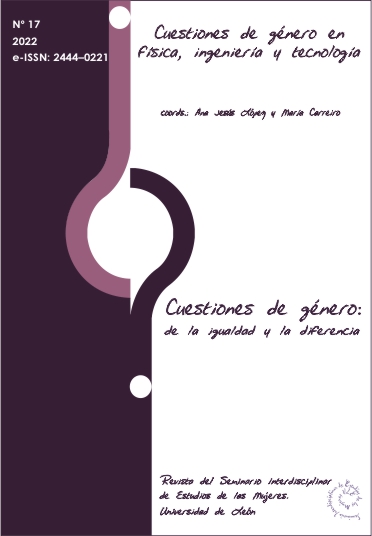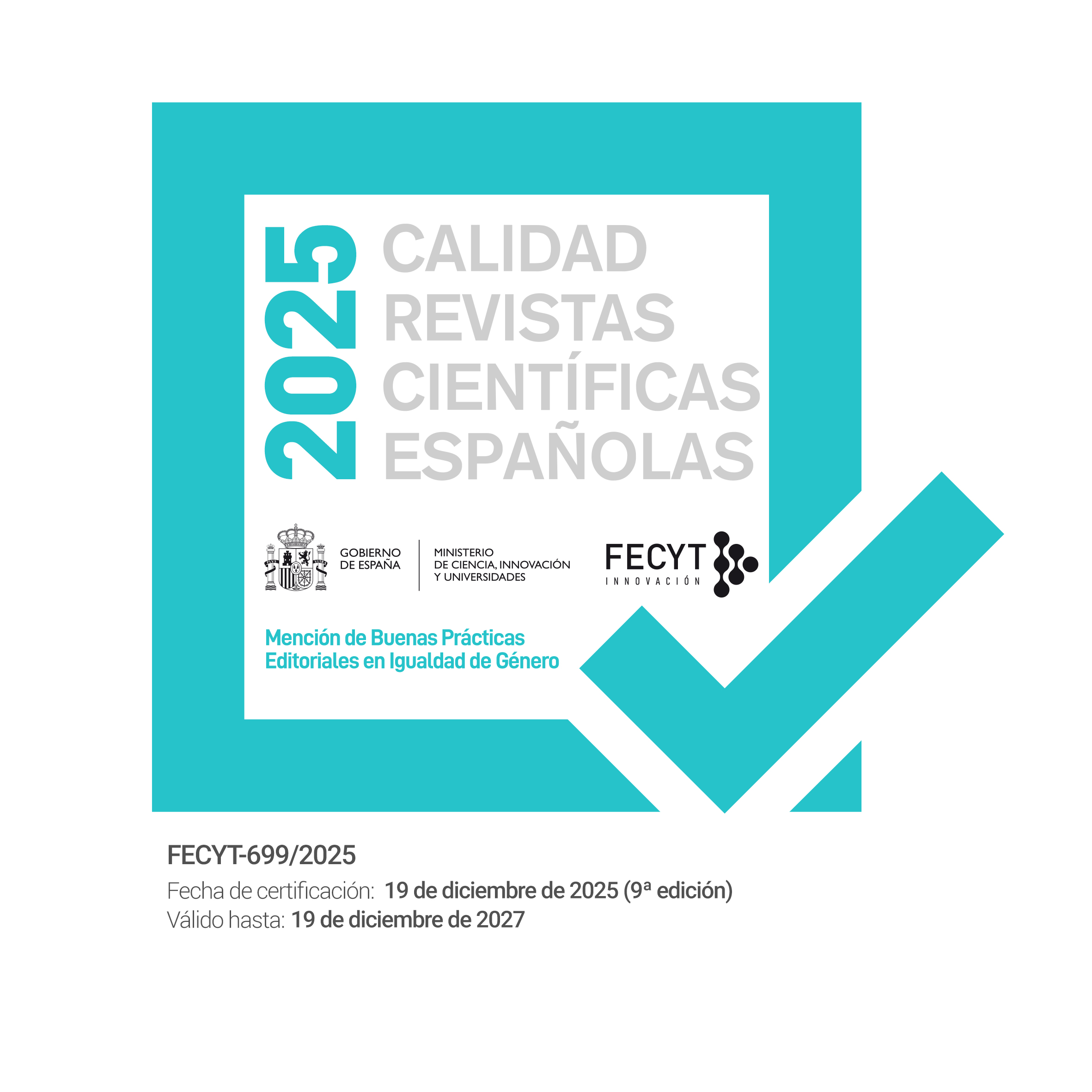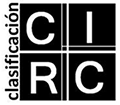Iniciativas de mujeres en la intersección del arte y la tecnología: un mapeo del caso español
DOI:
https://doi.org/10.18002/cg.i17.7254Palabras clave:
mujeres, arte, tecnología, mapeo, TIC, autogestión, iniciativas, feminismosAgencias Financiadoras:
Fondo Social Europeo - Generalitat ValencianaResumen
El presente artículo es una exploración de las iniciativas autoorganizadas de mujeres que han surgido en la intersección del arte y la tecnología en España. A nivel internacional, las primeras formas colectivas han ido apareciendo en lugares donde existe una escena de arte y nuevos medios, la cual es generalmente de dominación masculina y baja en diversidad. Este artículo muestra los resultados particulares de un mapeo de este fenómeno tecno-social y artístico a nivel nacional. A través de entrevistas y métodos de investigación etnográfica, se examinan las diferentes tipologías formatos y objetivos de estas iniciativas en relación a conceptos de resistencia cultural, redes y comunidad creativa.
Descargas
Métricas alternativas
Citas
Aguilar y Wedge, Carmen; Tankal, Ece y Clark, Ashley (2019): “On bringing the future into the present through radical collaboration”. En: The Creative Independent. Entrevista por by Willa Köerner. Disponible en: https://bit.ly/2wkReGN [21/10/2019].
Ajuntament de Barcelona (2014): “El llegat de Bonnemaison, encara vigent” [vídeo], 6 de marzo de 2014. Disponible en: https://bit.ly/2lovPqO [23/07/2019].
Atenea (2022): “IV Conferencia Internacional Atenea: La Posesión desmaterializada”. Disponible en: http://www.atenea.in [15/01/2022].
Bazzichelli, Tatiana (2008): “The Net as Artwork, Digital Aesthetics Research Center, Arhus University”. Disponible en: http://www.digital-aestetik.dk [01/06/2022].
Bertomeu, Angustias (2004): “Fundación del Portal e-leusis.net”. En: e-mujeres. Disponible en: https://e-mujeres.net/fundacion-del-portal-e-leusis-net [03/02/2019].
Bertomeu, Angustias (2006): “Arte Electronico, e-mujeres”. Disponible en: https://e-mujeres.net/fundacion-del-portal-e-leusis-net [03/02/2019].
Bionicas, Bionica1.0. Disponible en: http://www.bionicas.net [01/02/2022].
Birnbaum, Paula J. (2019): “The Exhibitions of the Femmes Artistes Modernes (FAM), Paris, 1931-38”. En: Artl@ s Bulletin, vol. 8, nº. 1, pg.10. Disponible en: https://bit.ly/2kk9LNK [01/06/2022].
Blair, Karen J. (1994): The torchbearers: Women and their amateur arts associations in America, 1890-1930. Estados Unidos: Indiana University Press.
Bloch, Nadine (2012): “Cultural resistance: The art of protest”. En: New Tactics in Human Rights. Disponible en: https://bit.ly/2UKDKhJ [01/11/2019].
Boix, Montserrat (2006): “Hackeando el patriarcado en la lucha contra la violencia hacia las mujeres. Filosofía y práctica de mujeres en red desde el ciberfeminismo social”. En: Labrys, Études féministes, nº. 10, junio/diciembre. Disponible en: https://www.mujeresenred.net/spip.php?article880 [01/11/2019].
Campbell, Rebbeca y Deborah A. Salem (1999): “Concept mapping as a feminist research method”. En: Psychology of Women Quarterly, vol. 23, nº. 1, pp. 65-89. Disponible en: https://doi.org/10.1111/j.1471-6402.1999.tb00342.x [01/06/2022].
Caramés Sales, Ánxela (2016): “Las prácticas curatoriales feministas en el Estado Español (1993-2013). La gestión cultural como productora del discurso de las identidades de género”. Tesis doctoral, Universitat Politècnica de València. Disponible en: https://riunet.upv.es/handle/10251/62863 [01/06/2022].
Cardoso, Marise [Entrevista], Skype, 12-03-2019.
Cargo Collective (n.d.): “Elas Fan Tech”. Disponible en: https://cargocollective.com/elasfantech [03/05/2022].
Castells, Manuel (2001): The Internet galaxy: Reflections on the Internet, business, and society. Oxford: Oxford University Press.
Chidgey, Red (2009): “DIY Feminist Networks in Europe: Personal and Collective Acts of Resistance”. En: Transform!europe. Disponible en: https://bit.ly/31NTYYH [15/12/2019].
Collins, Patricia Hill (2000): “Gender, black feminism, and black political economy”. En: The Annals of the American Academy of Political and Social Science, vol. 568, nº. 1, pp. 41-53. Disponible en: https://bit.ly/2lkpT1K [12/01/2020].
Cox, Donna J. et al. (2018) (eds.): New media futures: The rise of women in the digital arts. Illinois: University of Illinois Press.
Donestech (2009): “Lelacoders”. Disponible en: https://donestech.net/lelacoders [10/10/2019].
Duncombe, Stephen (2007): “From Cultural resistance to community development”. En: Community Development Journal, vol. 42, nº. 4, pp. 490-500. Disponible en: https://doi.org/10.1093/cdj/bsm039 [01/06/2022].
e-leusis (1999, 2001): “Historia e-leusis”. Disponible en: https://e-mujeres.net/ [08/06/20219].
Ember, Carol R. y Melvin Ember (2003) (eds.): “Gender-based social groups”. En: Encyclopedia of Sex and Gender, vol. 1; Cultures LZ, vol. 2. Springer Science & Business Media.
FemTek (2018): “FemTek 2018”. Disponible en: http://www.femtekbilbao.net/ [05/05/2019].
Futch, Valerie A. y Michelle Fine (2014): “Mapping as a method: History and theoretical commitments”. En: Qualitative research in psychology, vol. 11, nº. 1, pp. 42-59.
Graham, Julie. (1980): “American Women Artists' Groups: 1867-1930”. En: Woman's Art Journal, vol. 1, nº. 1, pp. 7-12.
Gonnard, Catherine y Elisabeth Lebovici (2007): Femmes artistes, artistes femmes: Paris, de 1880 à nos jours. París: Hazan.
González, María José (2011): “El Lyceum Club de Barcelona”. En: Moments històrics de les dones a Catalunya. Disponible en: http://www.ub.edu/duoda/bvid/text.php?doc=Duoda:text:2017.02.0041 [01/06/2022].
Haraway, Donna (1985): “A manifesto for cyborgs: science, technology, and socialist feminism in the 1980s”. En: Socialist review, vol. 15, nº. 2, pp. 65-107.
Haraway, Donna (1989): “Introduction: The persistence of vision”. En V: Primate Visions. Gender, Race, and Nature in the World of Modern Science, pp.1-15. New York in London: Routledge.
Haraway, Donna (1991): Simians, cyborgs and women: the reinvention of nature. London: Free Association Books.
Hooks, Bell (1989): “Choosing the Margin as Space for Radical Openness”. En: The Journal of Cinema and Media, nº. 36: pp. 15-23. Drake Stutesman; Wayne State University Press. Disponible en: http://www.jstor.org/stable/44111660 [10/03/2019].
Llinàs Carmona, Conxa (2008): Feminismes de la transició a catalunya: Textes i materials. Barcelona: Horsori.
M-Artech (2012): “Open Call”. Disponible en: https://bit.ly/31XmcAo [01/06/2019].
Martínez-Collado, Ana (2011): “Prácticas artísticas y activistas feministas en el escenario electrónico: Transformaciones de género en el futuro digital”. En: Asparkía: investigació feminista, vol. 22: pp. 99-114.
Mereu, Francesca [video], 28-03-2012, Presentación de M-Artech, mujeres en artes y tecnología. Medialab Prado, Madrid. Disponible en: https://bit.ly/2V2W2L9 [10/07/2018].
De Miguel, Ana y Montserrat Boix (2002): “Los géneros de la red: los ciberfeminismos. El feminismo social”. En: Mujeres en Red. Disponible en: http://www.mujeresenred.net/spip.php?article297 [13/05/2019].
Mitchell, Caroline (1998): “Women’s (community) radio as a feminist public sphere”. En: Javnost - The Public, vol. 5, nº. 2, pp. 73-85. Disponible en: https://www.tandfonline.com/ [10/12/2018].
Mitchell, Caroline (2016): “Women and Radio – airing differences: On the Importance of Community Radio as a space for women’s representation, participation and resistance”. Tesis doctoral. University of Sunderland. Disponible en: http://sure.sunderland.ac.uk/id/eprint/6858 [10/12/2018].
MPavilion (2019): “Q&A: Global Collective Hypen-Labs on the Future of Women in Design”. En: MPavilion Magazine. Disponible en: https://bit.ly/2ka8n0g [02/08/2018].
Navarreta, Cynthia (1982): The Guide to Women’s Art Organisations and Directory for the Arts. New York City: Midmarch Associates (originally published in 1979).
Ortiga, Blanca [Entrevista], comunicación telefónica, 17-04-2019.
Paasonen, Susanna (2005): Figures of fantasy: Internet, women and cyberdiscourse. New York: Peter Lang.
Paasonen, Susanna (2011): “Revisiting cyberfeminism”. En: Communications, vol. 36, nº. 3: pp. 335-352. Disponible en: https://bit.ly/2HWtL1b [26/06/2019].
Parole di Queer [Entrevista], Messenger, 26-06-2019.
Paterson, Nancy [Entrevista], 09-12-997. Ict Nancy Paterson cyberfeminism 1997 for Kleurnet Television Amsterdam. Disponible en: https://bit.ly/2vUa0nY [01/05/2019].
Pérez-Hernández, María [Ptqk] (2006): Programmea EnRE/Dades. Disponible en: https://ptqkblogzine.blogia.com/2006/022701-programmea-enre-dades.php [01/07/02019].
Rahmani, Aviva (2014): “Communities of resistance: How ecological artists and scientists might help resist the environmental wars”. Disponible en: https://bit.ly/2Tkx4EO [05/11/2019].
Reynolds, SIÂN (2000): “Running away to Paris: expatriate women artists of the 1900 generation, from Scotland and points south”. En: Women's History Review, vol. 9 nº. 2, pp.327-344.
Ritchie, Jane; Lewis, Jane; McNaugthon Nicholls, Carol y Ormston, Rachel (2013) (eds.): Qualitative research practice: A guide for social science students and researchers. Estados Unidos: Sage Publication S.A.
Robles Mateo, Elena (2021): All-Women Initiatives in Art and Technology 1986-2020. Atenea: Mentoring and Networking Project in Steam. Tesis Doctoral. Universitat Politècnica de València. https://doi.org/10.4995/Thesis/10251/159248 [26/06/2019].
Smite, Rasa (2012): Creative Networks. Amsterdam: Institute of Network Cultures.
Smith, Fiona M. (1997): “Between east and west”. En: Cool Places: Geographies of Youth Cultures, pp. 290-305.
Spain, Daphne (1992): Gendered spaces. Estados Unidos: University of North Carolina Press.
Sollfrank, Cornelia (1998): “Women hackers”. En: Cornelia Sollfrank y Old Boys Network (eds.): First cyberfeminist international [exhibition programme]: pp. 78-79. Hamburg. Disponible en: https://www.obn.org/obn_pro/downloads/reader1.pdf [26/06/2019].
Sollfrank, Cornelia (2018): Die schönen Kriegerinnen. Technofeministische Praxis im
Jahrhundert. Viena: Transversal Texts.
Terpenkas, Andrea (2017): “Fluxus, Feminism, and the 1960's”. En: Western Tributaries, vol. 4, pp. 1-10. Disponible en: https://bit.ly/2jTRab3 [01/06/2022].
Tuer, Dot (2005): Mining the media archive: essays on art, technology, and cultural resistance. Toronto: yyZ Books.
Vergés Bosch, Núria; Cruells López, Eva y Hache, Alex (2009a): “Descrifrando el código Lela·”. [PowerPoint presentation] for X0y1. Disponible en: https://donestech.net/files/x0y1_prep_cast1.pdf [01/06/2022].
Vergés Bosch, Núria; Cruells López, Eva y Hache, Alex (2009b): “Retos y potencialidades para las mujeres en la participación del desarrollo de la sociedad de la información”. En: Feminismo/s, nº. 14, pp. 163-182. Disponible en: https://bit.ly/32jNa5p [01/06/2022].
VeNuS (2019): “VeNuS Matrix”. Disponible en http://www.vnsmatrix.net [02/02/2019].
Wajcman, Judy (2009): “Feminist Theories of Technology”. En: Cambridge Journal of Economics, vol. 34, nº. 1, pp. 143-152. Advanced publication. Disponible en: https://www.jstor.org/stable/24232027 [01/06/2022].
Wilding, Faith (1998): “Where is feminism in cyberfeminism?”. En: OBN online archive. Disponible en: https://www.obn.org/cfundef/faith_def.html [02/01/2019].
Wuschitz, Stefanie (2014): “Feminist Hackerspaces: A Research on Feminist Space Collectives in Open Culture”. Tesis doctoral. Vienna University of Technology.
Wuschitz, Stefanie y Savic, Selena (2019): “Feminist hackerspace as a place for infrastructure production”. En: Ada: A journal of gender, new media and technology, nº. 13. Disponible en: https://bit.ly/2uUaZVq [15/03/2019].
Zafra, Remedios (2009, 2014): “X0y1”. Disponible en: http://www.x0y1.net [13/03/2019].
Zafra, Remedios (2017): El entusiasmo. Precariedad y trabajo creativo en la época digital. Anagrama: Barcelona.
Descargas
Publicado
Cómo citar
Número
Sección
Licencia
Derechos de autor 2022 Elena Robles Mateo

Esta obra está bajo una licencia internacional Creative Commons Atribución-NoComercial-CompartirIgual 4.0.
L@s autores/as que publican en esta revista están de acuerdo con los siguientes términos:
1. L@s autores/as ceden de forma no exclusiva los derechos de explotación (reproducción, distribución, comunicación pública, transformación) a la Universidad de León, por lo que pueden establecer, por separado, acuerdos adicionales para la distribución no exclusiva de la versión de la obra publicada en la revista (por ejemplo, alojarlo en un repositorio institucional o publicarlo en un libro), con un reconocimiento de su publicación inicial en esta revista.
2. Este trabajo se encuentra bajo la Creative Commons Attribution-NonCommercial-ShareAlike 4.0 International License. Puede consultarse desde aquí la versión informativa y el texto legal de la licencia.
3. Se permite y se anima a l@s autores/as a difundir electrónicamente las versiones pre-print (versión antes de ser evaluada) y/o post-print (versión evaluada y aceptada para su publicación) de sus obras antes de su publicación, ya que favorece su circulación y difusión más temprana y con ello un posible aumento en su citación y alcance entre la comunidad académica.
Cuestiones de Género utiliza exclusivamente la licencia Atribución-NoComercial-CompartirIgual 4.0 Internacional (CC BY- NC-SA 4.0).
Bajo los siguientes términos:
- Atribución: Usted debe dar crédito de manera adecuada , brindar un enlace a la licencia, e indicar si se han realizado cambios . Puede hacerlo en cualquier forma razonable, pero no de forma tal que sugiera que usted o su uso tienen el apoyo de la licenciante.
- No Comercial: Usted no puede hacer uso del material con propósitos comerciales .
- Compartir Igual: Si remezcla, transforma o crea a partir del material, debe distribuir su contribución bajo la la misma licencia del original. cualquier uso permitido por la licencia.
No hay restricciones adicionales — No puede aplicar términos legales ni medidas tecnológicas que restrinjan legalmente a otras a hacer
L@s autores/as pueden consultar los derechos de copyright y las condiciones de autoarchivo en el directorio Dulcinea.











